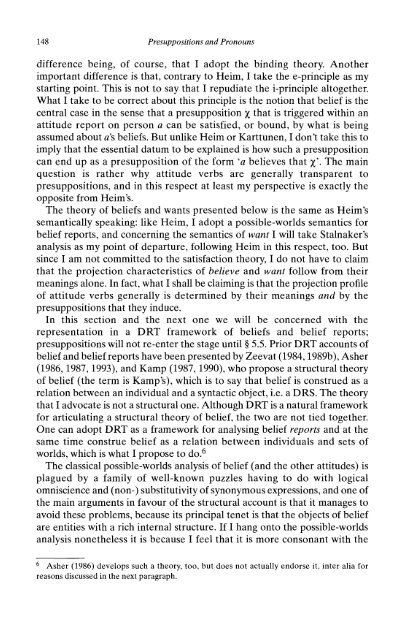Presuppositions and Pronouns - Nijmegen Centre for Semantics
Presuppositions and Pronouns - Nijmegen Centre for Semantics
Presuppositions and Pronouns - Nijmegen Centre for Semantics
Create successful ePaper yourself
Turn your PDF publications into a flip-book with our unique Google optimized e-Paper software.
148 <strong>Presuppositions</strong> <strong>and</strong> <strong>Pronouns</strong><br />
difference being, of course, that I adopt the binding theory. Another<br />
important difference is that, contrary to Heim, I take the e-principle as my<br />
starting point. This is not to say that I repudiate the i-principle altogether.<br />
What I take to be correct about this principle is the notion that belief is the<br />
central case in the sense that a presupposition X % that is is triggered within an<br />
attitude report on person a can be satisfied, or bound, by what is being<br />
assumed about a's «'s beliefs. But unlike Heim or Karttunen, I don't take this to<br />
imply that the essential datum to be explained is how such a presupposition<br />
can end up as a presupposition of the <strong>for</strong>m 'a believes that %'. X'. The main<br />
question is rather why attitude verbs are generally transparent to<br />
presuppositions, <strong>and</strong> in this respect at least my perspective is exactly the<br />
opposite from Heim's.<br />
The theory of beliefs <strong>and</strong> wants presented below is the same as Heim's<br />
semantically speaking: like Heim, I adopt a possible-worlds semantics <strong>for</strong><br />
belief reports, <strong>and</strong> concerning the semantics of want I will take Stalnaker's<br />
analysis as my point of departure, following Heim in this respect, too. But<br />
since I am not committed to the satisfaction theory, I do not have to claim<br />
that the projection characteristics of believe <strong>and</strong> want follow from their<br />
meanings alone. In fact, what I shall be claiming is that the projection profile<br />
of attitude verbs generally is determined by their meanings <strong>and</strong> by the<br />
presuppositions that they induce.<br />
In this section <strong>and</strong> the next one we will be concerned with the<br />
representation in a DRT framework of beliefs <strong>and</strong> belief reports;<br />
presuppositions will not re-enter the stage until § 5.5. Prior DRT accounts of<br />
belief <strong>and</strong> belief reports have been presented by Zeevat (1984,1989b), 1989b), Asher<br />
(1986,1987,1993), 1987, 1993), <strong>and</strong> Kamp (1987,1990), 1990), who propose a structural theory<br />
of belief (the term is Kamp's), which is to say that belief is construed as a<br />
relation between an individual <strong>and</strong> a syntactic object, i.e. a DRS. The theory<br />
that I advocate is not a structural one. Although DRT is a natural framework<br />
<strong>for</strong> articulating a structural theory of belief, the two are not tied together.<br />
One can adopt DRT as a framework <strong>for</strong> analysing belief reports <strong>and</strong> at the<br />
same time construe belief as a relation between individuals <strong>and</strong> sets of<br />
worlds, which is what I propose to do. 6<br />
The classical possible-worlds analysis of belief (<strong>and</strong> the other attitudes) is<br />
plagued by a family of well-known puzzles having to do with logical<br />
omniscience <strong>and</strong> (non-) substitutivity of synonymous expressions, <strong>and</strong> one of<br />
the main arguments in favour of the structural account is that it manages to<br />
avoid these problems, because its principal tenet is that the objects of belief<br />
are entities with a rich internal structure. If I hang onto the possible-worlds<br />
analysis nonetheless it is because I feel that it is more consonant with the<br />
6<br />
6 Asher (1986) develops such a theory, too, but does not actually endorse it, inter alia <strong>for</strong><br />
reasons discussed in the next paragraph.














